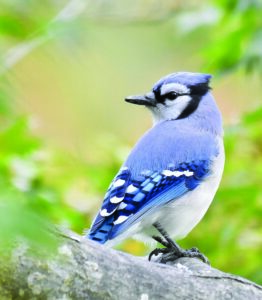(Editor’s note: Suzette Stitely is a member of the Talbot Bird Club and travels extensively for birdwatching.)

The blue jay has a lovely pattern of blue, black and white on its body a perky crest, black necklace and white face mask. (Photo by Suzette Stitely)
Even if you’re not a bird-watcher, you are no doubt familiar with the Blue jay. Colorful, noisy and numerous at times the Blue jay is hard to miss.
One of our most beautiful birds, the Blue jay has a lovely pattern of blue, black and white on its body and it sports a perky crest, black necklace and white face mask.
Put out some peanuts this winter and you’ll be visited by blue jays.
You’ll hear them before seeing them as they give a loud “jay jay” call to let others know about the feast.
Did you know that Blue jays are good mimics? They are especially good at Red-shouldered Hawk calls and have tricked me many times.
As a member of the crow family (Corvidae), Blue jays are intelligent birds and will remember where they stash food.
Their summer diet is mostly insectivorous including spiders, grasshoppers and beetles. In winter, they switch to acorns so native trees are essential for their survival.
Found in most of North America, Blue jays do migrate and the birds at your winter feeder may not be the same ones that nest nearby in the summer.
Blue jays form monogamous pairs and work together for successful nesting. Eggs hatch after about 17 days and it’s another three weeks before nestlings leave the nest.
Parents continue to feed them for another month or so as the fledglings learn to gather food and perfect their flight. If they’re fortunate, they can expect to live for seven to eight years in the wild.
Learn more about birds, including the Blue jay, by joining the Talbot Bird Club.
The Talbot Bird Club welcomes anyone who has an interest in birds, whether a novice or experienced ornithologist, and whether you enjoy watching birds at your feeder or traveling throughout the world.
Our members learn from one another and are willing to share their knowledge.
The Talbot Bird Club is part of the Maryland Ornithological Society.
You can reach out for more information through the club’s Facebook page.



